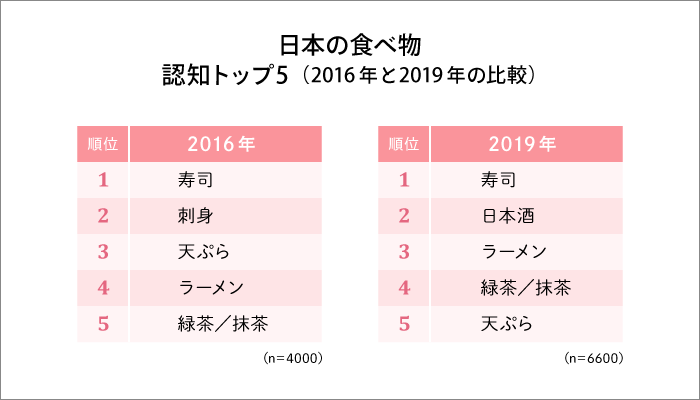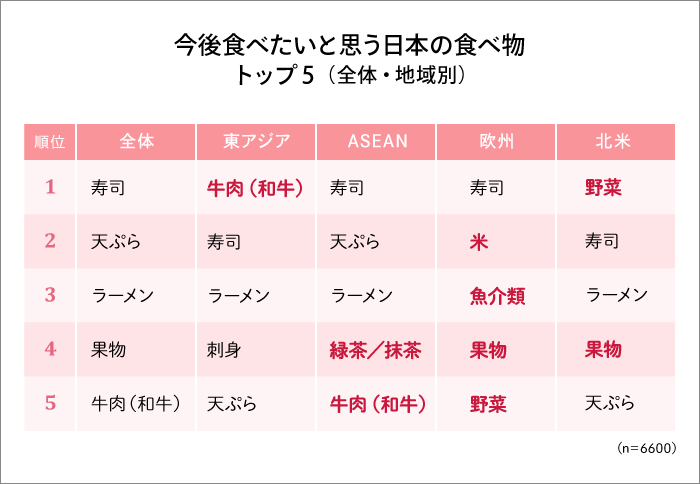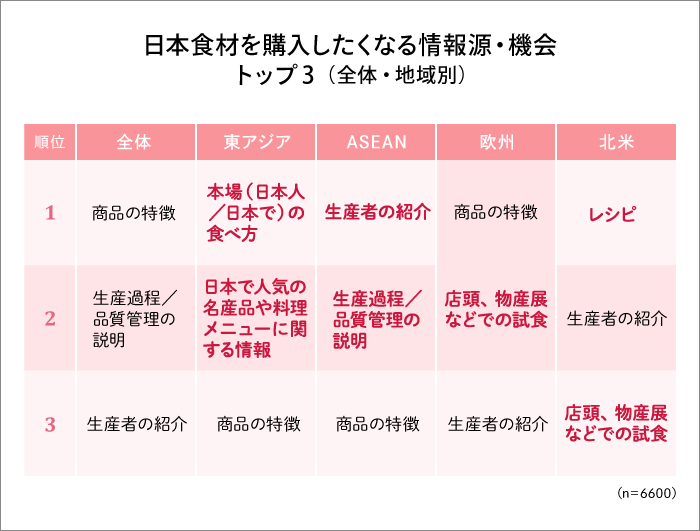In Part 3 of this series, we introduced that "eating Japanese food" ranked as the top thing people want to do in Japan. In Part 5, we showed that "Japanese food" topped both the list of Japanese things respondents thought were excellent and the list of Japanese things they were interested in.
Japanese cuisine restaurants are common even in destinations popular with Japanese travelers, such as Asian countries, Hawaii, and New York. While "Japanese food" used to be almost synonymous with "sushi," what is the situation now?
This series explores insights for future inbound business from the "Japan Brand Survey 2019," conducted in 20 countries and regions in December 2018. This time, we focus on "Japanese food" and delve deeper.
"Sushi is synonymous with Japanese food" remains true. New additions: "Japanese sake" and "ramen"!
When asked what Japanese foods they know, "sushi" ranked first. This was followed by "sake" and "ramen." While awareness of "sake" is high, perhaps due to it being an alcoholic beverage, experience and future intent are not as strong. "Ramen," which has high experience and future intent, seems to be more globally popular.
Breaking it down by gender and age, women, especially younger women in their 20s and 30s, tended to be more familiar with Japanese food, particularly Japanese cuisine. Among women in their 20s, awareness of "ramen" exceeded 60%, and "soba/udon" was known by half, showing generally high scores overall.

Looking at the results from three years ago (2016), "sushi" topped the charts in awareness, experience, and future intent. This trend has remained unchanged since the survey began, maintaining its unshakable first-place position.
However, comparing "awareness" specifically reveals significant shifts in the rankings below first place, indicating a rapid expansion in the breadth of Japanese cuisine over these three years. "Sake," previously unranked in the top positions, rose to second place, while "ramen," previously fourth, surpassed "sashimi" and "tempura" – long considered synonymous with Japanese food – to rank third.
This shift is likely heavily influenced by the experiences and word-of-mouth sharing of the many foreign tourists visiting Japan. In the 2018 survey, when visitors to Japan were asked "What did you do in Japan?", "Eating Japanese food" ranked first, cited by over 80% of respondents. Furthermore, videos showing foreign tourists surprised by the differences between Japanese food in Japan and what they eat back home have gone viral. The sharing of the authentic appeal and deliciousness of Japanese cuisine is likely deepening understanding and increasing interest in it.
Asia craves Wagyu, while Europe and America prefer vegetables and fruit. What people want to eat varies by region!

Next, examining responses for "Japanese foods they want to eat in the future" by region reveals distinct trends. In East Asia, "beef (Wagyu)" topped the list, surpassing "sushi." Beef also ranked 5th in ASEAN, highlighting Wagyu's popularity across Asia.
In contrast, "vegetables" ranked highest in North America. In Europe, the top five were dominated by ingredients: "rice," "seafood," "fruit," and "vegetables." While Western countries, especially Europe, may still be less familiar with the variety of Japanese cuisine, a strong interest in ingredients is a defining characteristic.
The 2018 survey asked about "perceptions of Japanese ingredients," with "high quality" and "attractive appearance (color, shape, etc.)" ranking highly.
As mentioned in the previous article regarding the image of "Made in Japan," high quality is highly valued. This same image applies to ingredients, suggesting future potential for visually appealing foods.
When do people want to buy Japanese food? Focusing on regional differences

Japanese ingredients and foods are highly sought after in Europe and America, and with the Japanese government's promotion, exports are expected to increase significantly in the future. What kind of initiatives would be effective in getting people to buy Japanese ingredients and foods?
In East Asia, where Japan is well-known, many people want to know "how it's evaluated and eaten in Japan itself." In ASEAN countries with high pro-Japan sentiment, there's a tendency to focus on "how the product was made in Japan," such as introducing producers and explaining the production process.
In Europe and North America, where Japanese cuisine is still relatively unknown, there is a clear tendency for consumers to first want to understand what the products are through "tasting" and learn how to use them. These findings highlight the renewed necessity of developing sales approaches tailored to each region and country, taking into account differences in psychological distance from Japan and the penetration level of Japanese cuisine.
Through this series focused on inbound tourism, I've realized that not only are foreign tourists increasing, but starting with them, we can see the growing image and appreciation of Japanese products, along with the spread of Japanese cuisine. It also became clear again that perceptions of Japan vary significantly by region.
Looking ahead to 2020 and the 2025 Osaka-Kansai Expo, business opportunities originating from inbound tourism will continue to expand. Next year, in particular, marks a pivotal turning point that will shape Japan's future. How can we leverage this opportunity to engage those who have not yet visited Japan or shown interest? We hope these survey findings will inform the development of strategies that can be sustained into subsequent years.
Japan Brand Survey 2019 Overview
・Purpose: To understand overseas consumers' perceptions and actual behaviors regarding the overall "Japan Brand," including food, tourism, and Japanese products
・Target Areas: 20 countries and regions
China (Group A = Beijing, Shanghai, Guangzhou; Group B = Shenzhen, Tianjin, Chongqing, Suzhou, Wuhan, Chengdu, Hangzhou, Dalian, Xi'an, Qingdao), Hong Kong, Taiwan, South Korea, India, Singapore, Thailand, Indonesia, Malaysia, Vietnam, Philippines, Australia, United States (Northeast, Midwest, South, West), Canada, United Kingdom, France, Germany, Italy, Russia, Turkey
*This time, Brazil—which showed little change in past survey trends—was excluded, while Turkey, gaining attention for inbound tourism, was added.
・Survey Method: Online survey
・Respondent criteria: Men and women aged 20–59 *Middle-income level and above
*Definition of "middle-income class" (income criteria): Criteria set for each country based on national average income (OECD statistics, etc.) and social class classification (SEC)
・Sample size: China: 300 each for A and B groups, total 600; USA: 600; Other regions: 300 each, total 6,600
・Survey Period: December 2018
・Research organization: Video Research Ltd.








